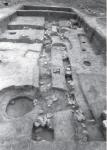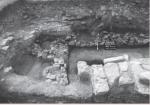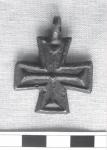Summary (English)
ARCHAEOLOGICAL EXPLORATIONS IN PLISKA (Lyudmila Doncheva–Petkova – ldoncheva_petkova@abv.bg, Konstantin Konstantinov) An area of 850 sq. m was explored in the southwestern corner of the Inner Town of Pliska. Building I was entirely excavated. The finds include small lead cross, a clasp for book and an anonymous Byzantine follis of class A2. Building II was discovered at 2.50 m to the north of building I. The Building is 11/15 m long and its interior is 3.88 m wide. The walls are 40 – 80 cm thick and are constructed of uneven stones bonded with mud. There are four later pits and two houses situated over building II. Building III, 5.70 m by 5.60 m in size, was discovered to the north of building II. There is an entrance, 80 cm wide, on its eastern wall. The finds include pottery, a marble disc and an anonymous Byzantine follis of class B. Two small houses, one of them sunken-floored, were explored over the debris of building II. The finds include sherds, a pot dated not later than the 10th century and a latch of a door. Five pits, containing animal bones, slag and sherds, were discovered to the west of building I. The finds include two anonymous Byzantine folles of class A1, 11 anonymous Byzantine folles of class A2, an anonymous Byzantine follis of class B, an anonymous Byzantine follis of class C, a bronze coin of Emperor Constantine X Doukas (1059 – 1067) that is a restrike of an anonymous Byzantine follis of class A2, 17 appliqués, five belt points, four buckles, glass bracelets, finger-rings, an earring-earpiece, a lead medallion, a Pecheneg pendant and eight crosses. The excavated building and materials date to the later period of Pliska from the 980s to 1060s. Probably, the buildings were constructed during the reign of Emperor Basil II (976 – 1025) and existed until Pliska was destroyed by the Oguzes in 1064.
- Lyudmila Doncheva–Petkova - Archaeological Institute and Museum
- Konstantin Konstantinov - Department of History and Archaeology, Shumen University Bishop Constantine Preslavski
Director
Team
Research Body
- Archaeological Institute with Museum
- Shumen University Bishop Constantine Preslavski






![Download [PDF]](/excavation/skins/fasti/images/results/download_sml.png)

